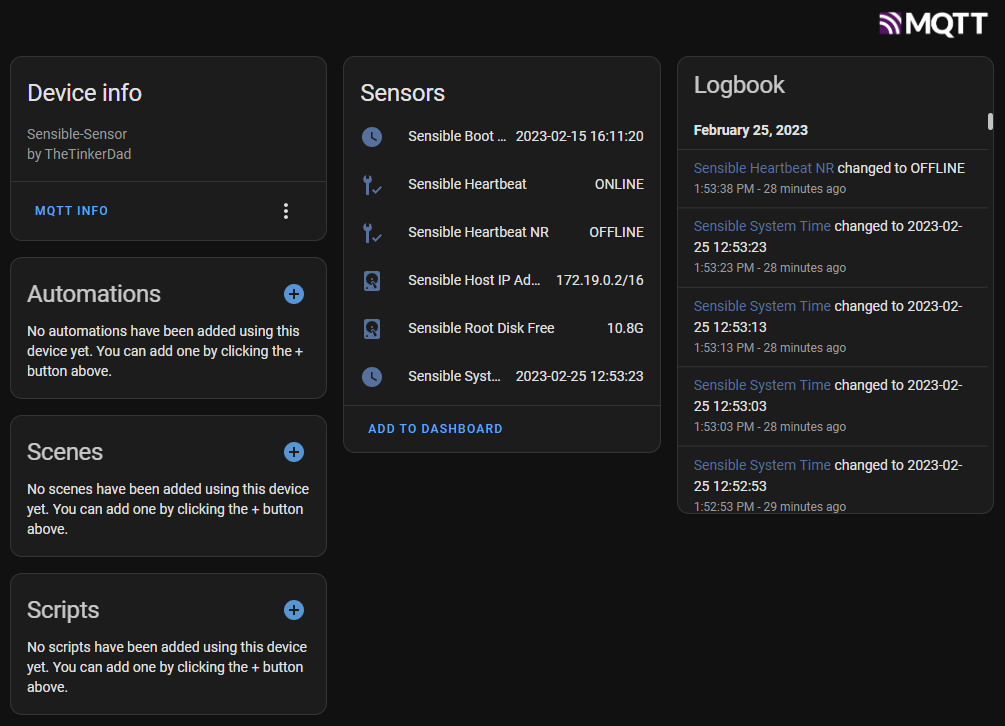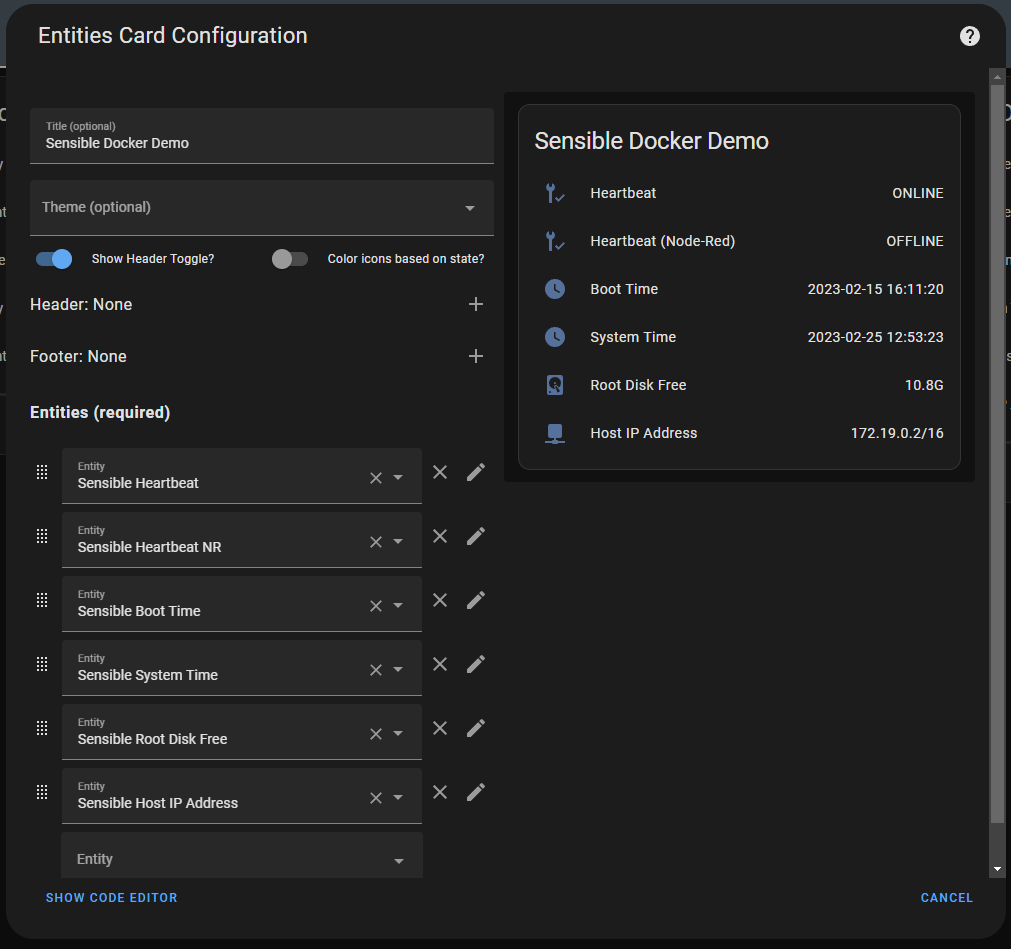What is Sensible?
A small tool that provides monitoring for your Linux server via Home Assistant sensors and MQTT discovery.
By default Sensible comes with only a few example sensors, but it is basically a framework that enables you to quickly prototype and implement your own sensors.
The below video showcases the first public version of Sensible and its capabilities. (This is the first installment of a tutorial / development update series.)
Why should you use Sensible?
-
It's tiny! Currently the binary is approximately 2.4Mb in size! You can put it into a Docker container and you won't even notice it's there!
-
Thanks to MQTT discovery, its integration with Home Assistant is as smooth as possible.
-
Because it follows basic MQTT / Home Assistant standards, it's easy to use with things like Lovelace UI, Node Red, you name it!
-
It's fully opensource with a permissive license! You can fork it on GitHub and make your own version!
-
It has a control REST API that enables disabling sensor data publishing, etc. (still WIP though)
-
The developer behind is a veteran with 20+ years of experience, so the project is here to stay, you can expect support and future updates!
Note: Yes, it's probably a temporary name, but I wanted to have something that at least a bit makes sense... (Pun intended!)
How it works?
Sensible is currently a framework application that works with Home Assistant and MQTT discovery. You can configure sensors as plugins for the framework and the sensors will appear in Home Assistant. There are currently two ways to implement sensors, although this part is still under development. First, you can code them in Golang and build them as part of Sensible. Second, you can implement them as unix shell scripts. In this case, you don't need to build Sensible, but you can use a prebuilt binary.
Quickstart guide
-
Currently only Linux is supported - if you're running other OSes, sorry, you'll have to wait!
-
Grab one of the releases from https://github.com/TheTinkerDad/sensible/releases or build Sensible on your own (see below)
-
The .tar.gz file only contains the binary, extract it somewhere convenient.
-
Run it the first time (e.g. ./sensible ) and it'll generate the default config file: /etc/sensible/settings.yaml
-
Kill the application by pressing Ctrl-C
-
Edit the config file
-
Scripts should be located under /etc/sensible/scripts
-
You can find the example scripts here or you can start by making your own, they are rather simple
-
Don't forget to update the config file to point to your scripts (see the plugins section of the config file)
Building Sensible
Being very early in development, Sensible is currently being built for Linux, using make:
This downloads the minimal dependencies required
make prepare
This one builds the executable and packs it with UPX
make build
Also builds the executable, but without applying UPX
make build
It is also possible to build example code for Docker, etc - see the Example usage section for this.
Configuration
This is currently done via a the file /etc/sensible/settings.yaml
A sample file looks like this
mqtt:
hostname: 127.0.0.1
port: "1883"
username: ""
password: ""
clientid: sensible_mqtt_client
discovery:
devicename: some-unique-identifier
prefix: homeassistant
plugins:
- name: Sensible Heartbeat
kind: internal
sensorid: heartbeat
script: ""
icon: mdi:wrench-check
- name: Sensible Heartbeat NR
kind: internal
sensorid: heartbeat_NR
script: ""
icon: mdi:wrench-check
- name: Sensible Boot Time
kind: internal
sensorid: boot_time
script: ""
icon: mdi:clock
- name: Sensible System Time
kind: internal
sensorid: system_time
script: ""
icon: mdi:clock
- name: Sensible Root Disk Free
kind: script
sensorid: root_free
script: root_free.sh
icon: mdi:harddisk
- name: Sensible Host IP Address
kind: script
sensorid: ip_address
script: ip_address.sh
icon: mdi:check-network
Example scripts
There are a couple of scripts under the examples/scripts folders that are also configured to act as sensors in the above example configuration file.
The only requirement for these scripts is that they should be simple, with an execution time no longer than 1-2 seconds and they should only output the value that is meant to be a sensor value. E.g. the ip_address.sh script only outputs an IP / CIDR.
Example usage
- A standalone systemd service on Linux servers
- Plugged into Docker containers as a background process
- Plugged into LXC/LXD containers as a service
- As a standalone service on Raspberry Pi's
- As a system service on Windows
Development and planned features
- Security! MQTT encryption and all the bells and whistles to make it production ready ASAP!
- There should be a way to implement sensors in Go for fully customized sensor data (plugin architecture) without rebuilding Sensible itself
- Authentication for the REST API and a way to disable it
- Documentation for the REST API
- A way to control Sensible via MQTT
- Configuration via environment variables
- A lot of small TODO items in the code


